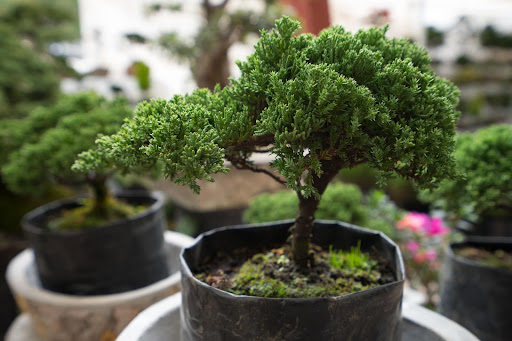bonsai, nature, tree
Bonsai Trees: Japan’s Tiny Sakura Trees & More
Christian Closs
Posted on March 21, 2022
Share:

The bonsai tree has penetrated the cultural zeitgeist, being an element of refined, zen culture recognised from almost every corner of the world. However, bonsai trees often leave many aspiring owners stumped.
Beginners come to the bonsai world due to the tree’s beautiful aesthetic but quickly ask, “How does one take care of a bonsai tree?” or “Where do bonsai trees come from?” when researching bonsai trees.
The team here at authentic Japanese snack box Sakuraco are huge fans of bonsai trees and aspires to take care of our mini tree one day. Often a confusing and mysterious plant with a reputation for being high maintenance, we’ll look into these gorgeous tiny trees with a religious background today.
Bringing the “Outside” Inside
The story of the bonsai tree begins in China somewhere within the first millennium C.E., Originally cultivated by Buddhist monks. Their goal was to bring the outdoors into the indoor space, particularly temples. The actual date they first appeared is not explicitly precise. However, many believe that small potted trees first appeared between 500 and 1000 B.C.E.
Appearing in Chinese art in the early common era (around 600 C.E.), it reflected a love of miniatures the Chinese people held, as it was believed that they held certain powers. Some even made miniature gardens, complete with trees and shrubs. The ceramic pot they were held in was of equal importance, creating a harmonious feeling between the miniature and the container in which it was kept.
Introduction to Japan
Over time, cultivating miniature gardens, specifically miniature trees, spread to Korea and Japan as Chinese influence spread across the East Asian region. The difference between the Japanese and Chinese bonsai trees is how well groomed they are, with Japanese ones being highly groomed and Chinese trees being more focused on their natural form.

Japan sought to increase the quality of these miniature trees. As time went on, Japanese trees became world-renowned. During the post-World War Two period, as Japan became a symbol of success in the global stage, bonsai trees made in Japan became heavily sought after thanks to their superior quality. Through this, Japan became synonymous with bonsai trees.
What are Bonsai Trees?
Bonsai trees are miniature trees that are meticulously cultivated and pruned to increase their aesthetic quality. Originating in Japan, bonsai trees have gained worldwide recognition for their unique and intricate beauty.
In the post-WWII era, Japan’s success on the global stage brought further attention to bonsai trees, which were seen as a symbol of the country’s superior craftsmanship and attention to detail. As a result, bonsai trees made in Japan became highly sought after and are now synonymous with the country’s cultural identity.
Bonsai Trees in the Modern Era
Today, getting started with your bonsai tree is more possible. With many guides online about caring for a bonsai tree, even beginners can start with this hobby with a heavy influence and focus on Zen. You can cultivate your bonsai sakura tree, keeping spring closer to you than ever.

Authentic Japanese snack box Sakuraco has a wide range of seasonal treats that perfectly match a spring picnic or cozy winter inside enjoying a bonsai tree. Experience Japan’s best offers, from sakura-flavored Japanese sweets unmissable mochi and so much more. Discover what delicious snacks are coming to our Sakuraco family this month.
Undeniably, bonsai plants can be very high maintenance and might not be possible for everyone to raise. For those people, a Lego bonsai tree could be an option, balancing elegance, practicality, and a quirky sense of style.
Taking Home a Little Piece of Japan
Bonsai trees allow people to have a little piece of Japan in their homes (quite literally). With the care and love they require, many find cultivating these trees a challenging but enriching Japanese pastime.
Another beloved Japanese pastime is enjoying delicious food and drink in nature. The importance of matching your food or Japanese tea to the season can not be overstated, and a suitable match can bring out the full seasonal experience that has been beloved in Japan for centuries.

Discover authentic flavors with Sakuraco
Get Sakuraco 

Discover authentic flavors with Sakuraco
Get Sakuraco 
Related Articles

Ebisu: The Cheerful Guardian of Luck and Prosperity
Religion in Japan involves a dizzying array of spirits and beings. These gods are inspired by ancient tales and used to symbolize nature’s bounty. However, they also profoundly impact daily life and are often sought out for help in challenging times

Little New Year in Japan: Discovering Koshogatsu Traditions
When people think of the Japanese New Year, they typically associate it with January 1st. It’s a time for celebrations, family, special foods, and visits to shrines for hatsumode (first prayer of the year).

Hatsumode: Why Is It Japan’s Most Important Tradition?
Hatsumode is the first visit to a shrine or temple in the New Year in Japan, and it is one of the country’s most important traditions. Every year, millions of people participate, demonstrating the profound connection between this custom and daily life.

Japanese Fish Bait: The Beautiful Art of Kebari
Kebari are traditional hand-tied flies used for freshwater fishing in Japan, especially in mountain streams where small insects form the main diet of native fish. Instead of bright plastic lures, kebari use feathers, thread, and natural materials to create subtle movements in the water.



